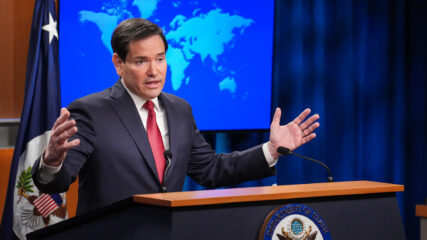Diversity is one of Israel’s most distinctive features. Finding common ground on sacred ground, Israeli Jews have returned to their homeland from more than 100 countries, forming a population of diverse culture, religious observance and Jewish experience.
What Israel’s demography reveals, its ecology reflects. As if describing this mirroring of nation and nature in a state he would never know, the beloved Hebrew poet Shaul Tchernichovsky wrote in his most famous poem, “Man is but a small piece of land, an image of his homeland’s landscape.”
“Small piece of land” though it is, Israel ranks among the world’s most ecologically diverse countries. Spatially, Israel might, in the spirit of Chaim Weizmann’s remark that “we should accept a state even if it were the size of a tablecloth,” be likened to a tablecloth; ecologically, however, it’s a tapestry.
Israel’s ecological compression is such that the Jewish state spans four major biogeographic zones — Mediterranean, Irano-Turanian, Saharo-Arabian and Sudanian — and the ecosystems of three continents — Europe, Asia and Africa. Of Earth’s five major biomes — large geographic zones defined by climate and plant and animal life — all but tundra are telescoped into a country no larger than New Jersey.
So rich is the biodiversity sustaining Israel’s four biomes — grasslands, woodlands, wetlands and drylands — that a well-traveled visitor to Israel might experience a sense of familiarity.
In the far north, snow-capped Mount Hermon shelters an Alpine ecosystem evocative of southern Europe, with wildflowers and mountain birds flourishing in a climate unlike any other part of Israel.
In the rest of the north and the center of the country, the Mediterranean region is defined by evergreen forests and dense shrublands. The Galilee, Mount Carmel and the Judean Hills are home to rich woodlands of oak, carob and terebinth trees and recall the coastal ranges of southwestern Sicily. These Israeli forests support such mammals as wild boars, jackals and porcupines, alongside an array of birds of prey.
The southern reaches of Israel, including the Negev Desert and the Arava Valley, present arid and semi-arid zones. The rocky plateaus, gravel plains and seasonal riverbeds of the driest parts of the Arava and Negev evoke the Sahara, while the acacia savannas of the northern Negev and eastern Arava suggest a miniature version of Africa’s Serengeti. Desert-adapted species such as the Nubian ibex, sand fox, desert monitor lizard and other reptiles, and many kinds of insects thrive in these landscapes defined by scarcity.
Water ecosystems, while less extensive, are crucial to Israel’s biodiversity, from the Mediterranean coast to the Dead Sea. The Hula Valley, once a vast swamp and now partly restored, provides habitat for wetland species such as the European otter and migratory birds. The Sea of Galilee, along with scattered springs and streams, supports amphibians, freshwater fish and aquatic plants.
Those varied species make Israel a veritable Noah’s Ark relative to its size. It was even richer in the past. Hippos once drifted through Israel’s swamps, and lions prowled its forests until five centuries ago. Sightings of the Asiatic cheetah, the Syrian brown bear and the Nile crocodile were documented well into the 20th century.
Israel’s animal kingdom still counts nearly a thousand royal subjects, including around 100 mammal species, 100 reptile species and more than 500 types of birds. Every spring and summer, Israeli skies transform into superhighways for millions of migratory birds crossing the intersection of three continents between breeding and wintering grounds. This global flyway runs the length of the country, from north to south, and has made Israel a hotspot for birdwatchers and researchers.
Alongside its avian wealth, Israel is home to around 2,600 species of plants, some found nowhere else. From ancient cultivars including olives, dates and barley to such native hardwoods as carob, oak and cypress, that greenery stabilizes, nourishes, connects, reclaims, transforms and renews the ecosystem.
As for the human role in the biosphere, Israeli successes have been many and remarkable — nowhere more so than in water reclamation and management. Some 80% of Israel’s potable water is sourced from five desalination plants along the Mediterranean coast. About 90% of Israeli wastewater is recycled after treatment, the highest percentage in the world by far, with half of the reclaimed sewage used for agricultural irrigation.
Israeli hydroengineering has affected the distribution of water no less than the composition of it. The Israeli invention of drip irrigation delivers agricultural water with maximal efficiency, eliminating surface runoff. Thanks to such ag-tech innovations, Israeli ingenuity has transformed the old Zionist imperative of “save every drop” into a reality.
Grassroots movements, conservation nonprofits and educational programs engage the population in protecting the land. The Society for the Protection of Nature in Israel, among others, has played a vital role in fostering awareness and action.
Israel’s conservation successes include the reintroduction of species such as the Persian fallow deer and Arabian oryx, solar energy generation, protected area designation (nature reserves cover 28% of the country), and environmental rehabilitation. Large-scale afforestation projects, led by organizations such as the Jewish National Fund, have turned barren areas into green landscapes. Israel converted its largest landfill, Hiriya, a towering trash heap of Babel, into an environmental park.
Yet the Jewish state is a far cry from Isaiah’s messianic vision of a biological utopia. Removing the green-tinted glasses reveals government mismanagement and inaction that have cast a pollution cloud over Israeli eco-achievement. Many problems, some of them dire, remain to be addressed as the human population grows: curbing biodiversity loss and habitat fragmentation, limiting invasive species and poaching, reducing emissions and water pollution, responding to regional water scarcity and deforestation, restoring rivers and aquifers, improving waste management, and expanding renewable energy.
Whatever the failures of Israeli officialdom, a government is not its people, and Israeli public surveys have consistently shown that public policy does not reflect popular will in matters of conservation. In other words, Israeli sympathies lie more with the land than with its lords, a spirit captured in the words of the country’s foremost nature poet, Esther Raab: “My heart is with your dews, o homeland.”
In sum, Israel’s ecology is a vibrant if fragile tapestry woven from desert winds and forest canopies, migratory wings and rooted trees, ancient hills and modern innovation. It is a land where nature and nationhood intertwine and where the story of the land is still being written in every footprint, flight path and forest planted.









